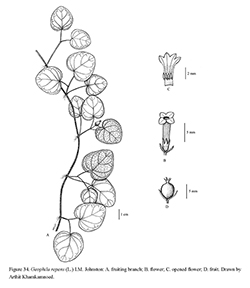e-Flora of Thailand
Volume 15 > Part 1 > Year 2021 > Page 197 > Rubiaceae > Geophila
1. Geophila repens (L.) I.M.Johnstonwfo-0000972431
Sargentia 8: 281. 1949; Verdc., Fl. Trop. E. Africa, Rub. (Part 1): 110. 1976; Tao Chen & C.M.Taylor in Z.Y.Wu et al., Fl. China 19: 144. 2011.— Rondeletia repens L., Syst. Nat. ed. 10, 2: 928. 1759. Fig. 34.
Accepted Name : This is currently accepted.
Synonyms & Citations :
Description : Prostrate creeping stems (often beneath the soil surface) up to several meters long: ascending flowering shoots often not more than 10 cm long. Leaves reniform or orbicular, 2–4.5 by 2–4.5 cm, nearly as long as wide, base conspicuously cordate, apex broadly obtuse to subacute, green glossy above, glabrous, whitish green beneath, pale yellow pubescent on veins beneath, lateral veins 4–5 pairs, conspicuous beneath; petiole 0.5–5.5 cm long, pubescent. Calyx lobes cuspidate, 1–2 mm long. Corolla white; tube infundibular, 6–7 mm long; lobes triangular, 3–4 mm long. Filaments slender, 3–4 mm long; anthers oblong, ca 1.5 mm long. Style and stigma ca 8 mm long. Fruits red to scarlet berries, globose or ellipsoid, 4–5 mm long, glossy, with persistent calyx and 4 stigmas. Seeds 2, ellipsoid.
Thailand : NORTHERN: Tak (Doi Hua Mot), Phitsanulok; NORTH-EASTERN: Loei; SOUTH-EASTERN: Chon Buri (Si Racha), Chanthaburi, Trat; CENTRAL: Saraburi (Muak Lek); SOUTH-WESTERN: Phetchaburi (Kaeng Krachan NP); PENINSULAR: Chumphon, Surat Thani, Trang, Phangnga, Phuket, Nakhon Si Thammarat (Khao Luang), Satun.
Distribution : Widespread in tropical Africa including Madagascar, N to S America (type from Jamica) and Asia from Sri Lanka, S India through China to Indochina, Malesia to New Guinea, NE Australia and the Pacific Islands (see Note).
Ecology : Open or shaded, damp places in evergreen or partly deciduous forests, also as weed in plantations, 0–1,100 m alt.
Vernacular : Mali Din (มะลิดิน)(Trat, Central); uttaphit nam (อุตพิดน้ำ)(Pennisular).
CommonName : Snake Pennywort.
Uses: Medicinal. The plant is applied to sore legs as a poultice.
Notes: Razafimandimbison et al. (Amer. J. Bot. 101: 1102–1126. 2014) showed that the American and Asian-Pacific plants were resolved into different molecular clades. Therefore Lim et al. (2019), in the Flora of Singapore, separated these two clades on species level, with the Asian-Pacific (including Thai) plants classified as Geophila herbacea. Until now, however, no morphological differences between them were discussed. In this case it seems preferable to maintain the species in its wide sense, In fact, it might be a case of two subspecies within a single species, which is not contradicted by the molecular results.

